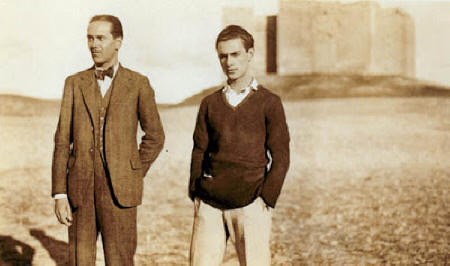

Partner Federico García Lorca, Luis Cernuda, Eduardo Blanco Amor
Queer Places:
Café Universal, Puerta del Sol, 14, 28013 Madrid, Spain
 Serafín Fernández Ferro (born August 12, 1914 in La Coruña - Mexico, 1957) known as Serafín Ferro, was a Spanish actor.
Serafín Fernández Ferro (born August 12, 1914 in La Coruña - Mexico, 1957) known as Serafín Ferro, was a Spanish actor.
He was born in the popular neighborhood of Monelos. Little is known of his life, most by indirect quotations in works and studies on the Generation of 27 of Spanish literature. He arrived in Madrid in the early 1930s, where he met Federico García Lorca and later Luis Cernuda, with whom he had an affair from 1931 until the spring of 1932. According to the story, a lad with the appearance of a beggar entered El Universal and went to García Lorca, who had just ordered a coffee and a cognac from the waiter: "Mr. García Lorca, why don't you invite me to a nugget? Today I still haven't eaten." Ferro did't have a penny, he wanted a job and he was willing to prostitute himself. Lorca was not attracted to "venal boys" but knew who may be interested. Both went to the house of Vicente Aleixandre, in Velintonia, where he wroye some notes of recommendation, among others to the poet Manuel Altolaguirre and his wife, Concha Méndez, who would hire Ferro as a linotyper in his new printing press, and Luis Cernuda, for whom he saw in Ferro an ideal companion... if it doesn't idealize it too much. The relationship was brief -no more than half a year- and stormy, but it left a definitive place in the Sevillian poet, to whom he inspired several poems, he dedicated To him The forbidden pleasures and whose rupture gave rise to his major work, Donde habite el olvido. "My archangel," Cernuda would call Seraphim, whom he also describes as a "terrible angel" and a "hostile vermin." "Angel, demon, floor of a dream love," he would write in a poem. Or "snake that I have long been curled in my heart," he says in Where Oblivion Dwells. On the back cover, a mysterious snake-shaped one that very few knew how to interpret. Already at the end of his life, the poet would acknowledge that it was a "sordid" relationship and his attitude with Seraphim, "too edid and too cowardly".

"Serafín Fernández Ferro por Ramón Gaya". Charcoal drawing on paper. Signed, dedicated and dated (32) in the lower right corner. Exhibitions: "Between reality and desire". Luis Cernuda 1902-1963. Residencia de Estudiantes, Madrid / Convento de Santa Inés, Seville. Bibliography: "Between reality and desire. Luis Cernuda 1902-1963". Edited by James Valender. Madrid, SECC/ Residencia de Estudiantes, 2002. Page 375. 32 x 24.5 cm

Serafin Ferro by Moreno Villa
This was how Ferro was introduced to what Lorca called epentismo, the circle of homosexuals of the Generation of 27, with whom the very young A Coruña man related and whose gatherings he frequented, among others that of the Chilean diplomat and writer Carlos Morla Linch, to which the two Andalusian poets, Rafael Martínez Nadal and the Galicians Eduardo Blanco Amor and Ernesto Guerra da Cal, went, and where literature and current affairs were combined with stories of love and jealousy. Xesús Alonso Montero does not doubt that Lorca and Serafín "were lovers, although perhaps occasional", and other testimonies coligen that more than a triangle there could be "a whole love polygon", of which Blanco Amor, confessed homosexual, would be part; Morla and even Guerra da Cal, both married. Seraphim, however, preferred women and, two years later, in 1933, he went to live with Catuxa, a beautiful and almost illiterate lucense, in a gloomy cuchitril near the Plaza de la Cebada.
"Of funny gesture and sweet voice," Lorca described him, and Guerra called him an "intellectualized golfantillo with airs of curly and brown elf." And more or less this is how the portrait taken by Ramón Gaya, who drew it in charcoal and color, and José Moreno Villa, portray it.
Ferro wrote verses in Spanish (Enamorado de nadie) and in Galician (Nouturnio de membranza, which he dedicated to the poet Gil Albert) and in 1939 was an actor in Sierra de Teruel, a film based on André Malraux's play L'espoir, a pre-war political film, based on the Spanish civil conflict. In 1935, after doing military service in the 3rd Infantry Regiment of Oviedo during the Asturias Revolution, he returned to A Coruña.
The relationship with Cernuda and the subsequent separation would inspire, according to Vicente Aleixandre, the book of poems Donde habite el olvido, published in 1934. He was linked to the anarchist trade union CNT and was self-taught. In Madrid he worked in the printing press of Manuel Altolaguirre and contacted the theatrical world, to the point of returning to La Coruña and directing the Keltya group to represent works by Yeats and Álvaro de las Casas, a project praised by Antón Villar Ponte. During that time he met Eduardo Blanco Amor. In 1936, after the start of the Civil War, although his name appeared by mistake on a list of those killed, he enlisted in the Spanish Legion with the insurrectionists; later during the siege of Madrid it was passed in the Casa de Campo to the republican side. He reached the rank of lieutenant and in Barcelona he wrote in the biweekly bulletin of Galician antifascist writers Nova Galiza and in Hora de España.
He fled to Portugal and Mexico, where he ended up poor and spoiled.
My published books:>